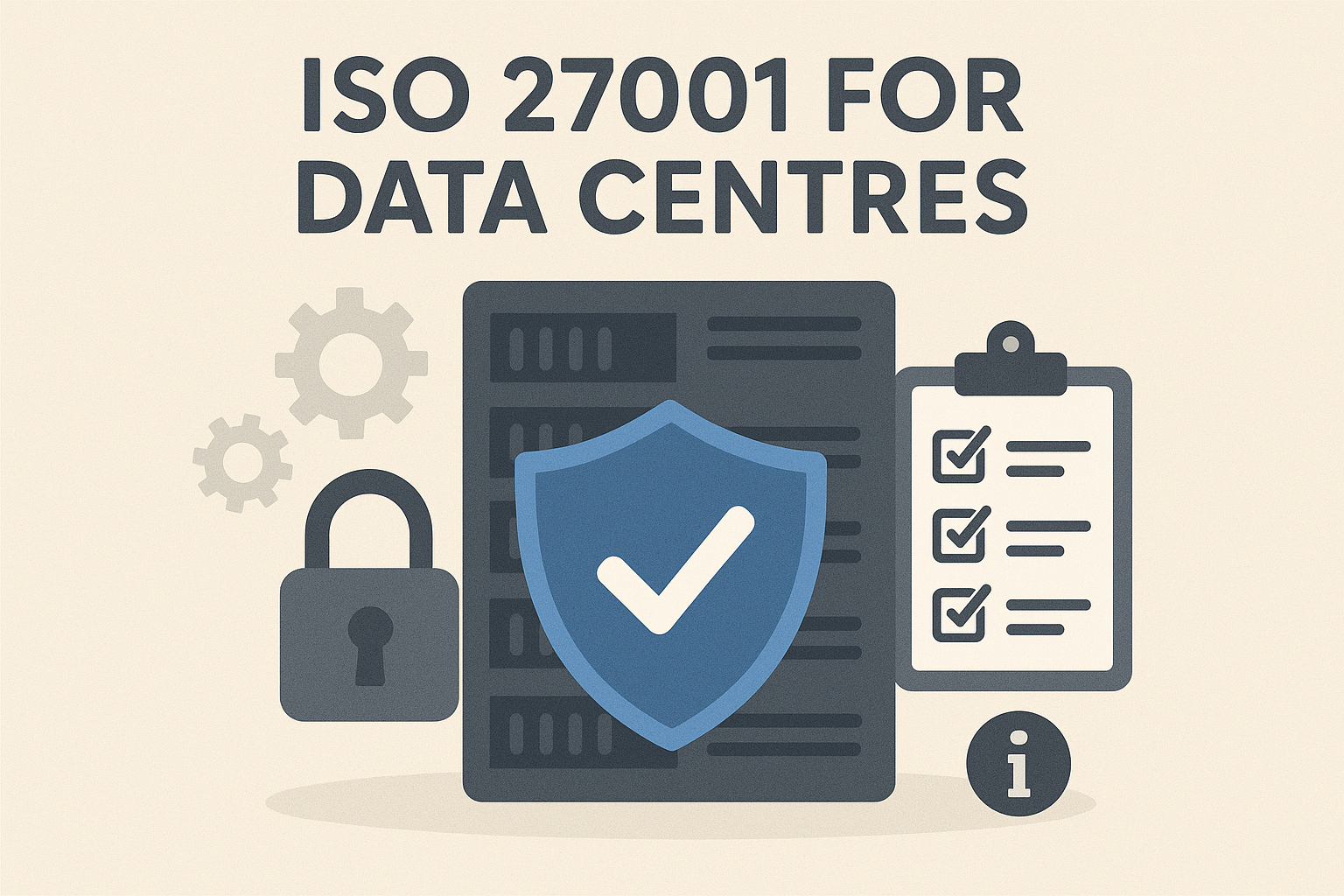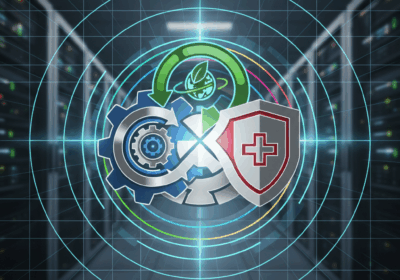ISO 27001 for Data Centres: Security Management Systems That Actually Work

ISO 27001 for Data Centres: Security Management Systems That Actually Work
Information security in data centres has evolved far beyond basic perimeter protection and access controls. As facilities become increasingly critical to global digital infrastructure, organisations require comprehensive security management systems that address the full spectrum of information security risks whilst maintaining operational efficiency and regulatory compliance. ISO 27001 provides the framework for such systems, yet implementation success varies dramatically depending on how organisations approach this complex standard.
Through our partnership with ASafe Global and extensive experience across hyperscale and colocation facilities, we have observed that effective ISO 27001 implementation requires deep understanding of data centre operational realities rather than generic security frameworks. Facilities that achieve meaningful security improvements through ISO 27001 adopt tailored approaches that integrate information security management with operational excellence and business continuity requirements.
Many organisations struggle with ISO 27001 implementation in data centre environments because they misunderstand the standard’s intent and scope. Rather than providing prescriptive security controls, ISO 27001 establishes a risk-based framework for developing, implementing, and continuously improving information security management systems. Success depends on intelligent application of this framework to data centre-specific risks and operational requirements.
Understanding ISO 27001 in Context
ISO 27001 certification has become increasingly important for data centre operators as clients demand demonstrable security management capabilities. However, certification alone provides limited value unless underlying security management systems effectively address real operational risks and support business objectives.
Risk-Based Security Management
The foundation of effective ISO 27001 implementation lies in comprehensive risk assessment that identifies genuine threats to information security within data centre environments. These assessments must consider both traditional IT security concerns and operational risks unique to critical infrastructure facilities.
Physical security risks in data centres extend beyond basic access control to include environmental threats, supply chain vulnerabilities, and operational disruption scenarios. Effective risk assessments evaluate how these physical risks interact with information security requirements, ensuring security controls address realistic threat scenarios rather than theoretical concerns.
Cybersecurity risks in data centre environments involve complex interactions between facility management systems, client networks, and operational technology platforms. Risk assessments must understand these interconnections to develop security controls that protect information assets without compromising operational effectiveness or client service delivery.
Operational Integration Requirements
Data centres operate in environments where security controls must coexist with demanding operational requirements including continuous availability, rapid response capabilities, and complex stakeholder relationships. Security management systems that ignore these operational realities create friction that undermines both security and operational objectives.
Effective ISO 27001 implementation requires security controls that enhance rather than impede operational efficiency. This integration demands deep understanding of data centre operations and careful design of security processes that support operational excellence whilst maintaining robust information protection.
Staff training and competency development become particularly critical in data centre environments where operational personnel must understand both security requirements and complex technical systems. Security management systems must ensure personnel can respond appropriately to security incidents without compromising facility operations or client services.
Common Implementation Challenges
Data centre organisations frequently encounter specific challenges when implementing ISO 27001 that differ from typical enterprise deployments. These challenges emerge from the unique operational, technical, and commercial characteristics of critical infrastructure facilities.
Scope Definition Complexity
Determining appropriate scope for ISO 27001 implementation in data centre environments requires careful consideration of facility boundaries, client relationships, and operational dependencies. Many organisations struggle with scope decisions that affect both certification validity and practical security management effectiveness.
Multi-tenancy arrangements common in colocation facilities create particular scope complexities. Security management systems must address facility operator responsibilities whilst respecting client boundaries and avoiding conflicts with client security requirements. This balance requires sophisticated understanding of both technical and contractual relationships.
Operational technology systems including building management, power monitoring, and environmental control platforms present additional scope considerations. These systems often lack traditional cybersecurity protections yet perform critical functions that affect both facility operations and information security. Effective scope definition must address these systems appropriately without creating unmanageable complexity.
Control Selection and Implementation
ISO 27001 Annex A provides extensive control options, yet not all controls are appropriate or practical for data centre environments. Organisations must select controls that address genuine risks whilst supporting operational requirements and regulatory compliance obligations.
Access control implementation in data centres must balance security requirements with operational access needs for maintenance, monitoring, and emergency response activities. Controls that work effectively in office environments may prove impractical for facilities requiring rapid response capabilities and complex stakeholder access arrangements.
Change management controls must accommodate both planned maintenance activities and emergency response requirements. Data centre operations frequently involve urgent changes that cannot follow standard approval processes, requiring security controls that maintain protection whilst enabling rapid operational response when necessary.
Measurement and Continuous Improvement
Demonstrating security management system effectiveness in data centre environments requires metrics that reflect both security outcomes and operational impact. Traditional security metrics often fail to capture the complex relationships between security controls and operational performance.
Incident management in data centres must address both security incidents and operational disruptions that may have security implications. Effective measurement systems track incident patterns, response effectiveness, and improvement opportunities across both security and operational domains.
Management review processes must consider the dynamic nature of data centre operations and rapidly evolving threat landscapes. Static annual reviews prove insufficient for environments where risks and operational requirements change frequently, requiring more agile approaches to security management system evaluation and improvement.
Tailored Implementation Strategies
Successful ISO 27001 implementation in data centres requires strategies specifically designed for critical infrastructure environments. These approaches must address operational realities whilst maintaining rigorous security management standards.
Integrated Risk Assessment Methodologies
Effective risk assessment in data centres must consider multiple risk categories simultaneously including information security threats, operational disruptions, regulatory compliance requirements, and business continuity concerns. Integrated assessments identify risk interactions that single-domain evaluations often miss.
Threat modelling for data centre environments must consider both external attackers and insider threats whilst also addressing accidental incidents and operational failures that could compromise information security. This comprehensive approach ensures risk treatments address realistic scenarios rather than isolated threats.
Risk assessment frequency must reflect the dynamic nature of data centre operations and evolving threat landscapes. Quarterly assessments with continuous monitoring provide more effective risk management than annual evaluations that may miss significant changes in threat profiles or operational circumstances.
Operational Security Integration
Security controls must integrate seamlessly with existing operational procedures to ensure consistent implementation without compromising operational effectiveness. This integration requires careful analysis of operational workflows and stakeholder requirements.
Physical security controls must support operational access requirements whilst maintaining appropriate protection levels. Sophisticated access control systems can provide security whilst enabling efficient operations through role-based access, time-limited permissions, and audit trail capabilities.
Environmental monitoring systems can serve dual purposes of operational oversight and security monitoring. Integrated approaches leverage existing monitoring infrastructure to provide security benefits whilst avoiding duplicated systems and administrative overhead.
Stakeholder Engagement and Training
Data centre operations involve numerous stakeholders including operational staff, maintenance contractors, client representatives, and regulatory bodies. Security management systems must address the training and competency requirements for all stakeholder groups.
Role-based training programmes ensure each stakeholder group understands relevant security requirements without unnecessary complexity. Operational staff require different training from contractors or client representatives, yet all groups must understand their security responsibilities within the overall management system.
Regular competency assessments ensure training effectiveness and identify improvement opportunities. These assessments must consider both theoretical understanding and practical application of security procedures within operational contexts.
Technical Control Implementation
Data centres require sophisticated technical controls that address both traditional IT security concerns and operational technology protection requirements. These controls must function effectively within complex technical environments whilst supporting operational reliability and performance requirements.
Network Security Architecture
Data centre network security must balance client isolation requirements with operational monitoring and management needs. Network architectures must provide appropriate segmentation whilst enabling necessary operational access and monitoring capabilities.
Micro-segmentation approaches can provide enhanced security whilst maintaining operational flexibility. Software-defined networking capabilities enable dynamic security policies that adapt to changing operational requirements without compromising protection effectiveness.
Network monitoring systems must address both security and operational monitoring requirements. Integrated approaches provide comprehensive visibility whilst avoiding duplicated monitoring infrastructure and administrative complexity.
Identity and Access Management
Access management in data centres involves multiple identity domains including operational staff, contractors, clients, and automated systems. Comprehensive identity and access management systems must address all these domains whilst maintaining operational efficiency.
Privileged access management becomes particularly critical in environments where administrative access can affect both security and operational outcomes. Multi-factor authentication and session monitoring provide enhanced protection for privileged activities without creating unacceptable operational friction.
Role-based access control systems must reflect the complex operational requirements of data centre environments. Access roles must provide appropriate permissions for operational activities whilst maintaining security boundaries and audit trail requirements.
Incident Response and Forensics
Data centre incident response must address both security incidents and operational disruptions that may have security implications. Integrated response procedures ensure appropriate handling of complex incidents that span multiple domains.
Forensic capabilities must function effectively within data centre environments where evidence collection cannot compromise ongoing operations. Procedures must balance forensic requirements with operational continuity needs.
Communication protocols during incidents must address multiple stakeholder groups including clients, regulatory bodies, and operational teams. Clear communication procedures prevent confusion whilst ensuring appropriate notification and coordination.
Operational Procedures and Documentation
ISO 27001 implementation requires comprehensive documentation that addresses both security management requirements and operational procedures. This documentation must remain current and practical whilst supporting both certification requirements and day-to-day operations.
Policy Development and Maintenance
Information security policies for data centres must address operational realities whilst maintaining clear security requirements. Policies must provide practical guidance that operational staff can implement effectively without compromising security outcomes.
Policy review cycles must accommodate the dynamic nature of data centre operations and regulatory environments. Regular reviews ensure policies remain relevant and practical whilst maintaining compliance with evolving requirements.
Policy communication and training must ensure all stakeholders understand relevant requirements. Different stakeholder groups require different levels of detail and different presentation approaches to ensure effective understanding and implementation.
Procedure Documentation
Operational procedures must integrate security requirements seamlessly with operational activities. Procedures that treat security as separate activities create friction and increase the likelihood of implementation failures.
Emergency procedures must address security considerations whilst maintaining focus on operational response requirements. Emergency situations require clear priorities and streamlined procedures that address both operational and security concerns effectively.
Change management procedures must accommodate both planned changes and emergency modifications whilst maintaining appropriate security controls. Flexible procedures that can adapt to different change scenarios provide more effective control than rigid processes that cannot accommodate operational realities.
Record Keeping and Evidence Management
Data centres generate substantial amounts of operational and security-related information that must be managed appropriately to support ISO 27001 requirements whilst maintaining operational efficiency.
Log management systems must address both operational monitoring and security audit requirements. Integrated approaches provide comprehensive coverage whilst minimising storage and processing overhead.
Evidence retention policies must balance ISO 27001 requirements with operational storage limitations and client confidentiality obligations. Clear retention schedules and automated management systems ensure compliance whilst minimising administrative burden.
Continuous Improvement and Management Review
Effective ISO 27001 implementation requires continuous improvement processes that adapt to changing operational requirements and evolving threat landscapes. These processes must provide meaningful insights that drive actual improvements rather than simply meeting certification requirements.
Performance Monitoring and Measurement
Security management system effectiveness must be measured through metrics that reflect both security outcomes and operational impact. Metrics that focus solely on compliance activities provide limited insight into actual security effectiveness.
Key performance indicators must address risk reduction, incident prevention, and operational integration effectiveness. Balanced scorecards that consider multiple perspectives provide more comprehensive insight than single-domain metrics.
Trend analysis must identify both positive improvements and emerging concerns that require attention. Regular analysis enables proactive management rather than reactive responses to problems after they become significant.
Internal Audit Programmes
Internal audits must evaluate both compliance with ISO 27001 requirements and practical effectiveness of security controls within operational environments. Audits that focus solely on documentation compliance miss opportunities to identify operational improvements.
Audit programmes must address technical controls, operational procedures, and stakeholder competency through appropriate audit techniques. Different audit approaches suit different control types and stakeholder groups.
Audit finding management must drive actual improvements rather than simply documenting problems. Effective corrective action processes ensure audit findings result in meaningful enhancements to security management system effectiveness.
Management Review and Strategic Alignment
Management reviews must consider security management system performance within broader organisational and operational contexts. Reviews that treat security management in isolation miss opportunities to identify strategic improvements and resource optimisation.
Strategic alignment assessment ensures security management systems support business objectives whilst maintaining appropriate protection levels. Regular alignment reviews identify opportunities to enhance both security and operational effectiveness.
Resource allocation decisions must consider both compliance requirements and operational impact. Effective resource management ensures security management systems remain sustainable whilst delivering appropriate protection and operational support.
The complexity of data centre environments demands sophisticated approaches to ISO 27001 implementation that go far beyond basic compliance activities. Organisations that recognise information security management as integral to operational excellence achieve superior outcomes compared to those that treat security as separate compliance overhead.
Our experience through the AuditCo and ASafe Global partnership continues to demonstrate that integrated approaches to security management deliver superior protection whilst supporting operational objectives. As data centres become increasingly critical to digital infrastructure, effective information security management systems become essential rather than optional capabilities.
Success requires understanding that ISO 27001 provides a framework for developing security management systems rather than prescriptive requirements. Organisations that adapt this framework intelligently to data centre operational realities achieve both robust security and operational excellence, whilst those that implement generic approaches often struggle with both security effectiveness and operational integration.
For More Information Visit https://asafeglobal.com/ or contact info@auditco.com.au



